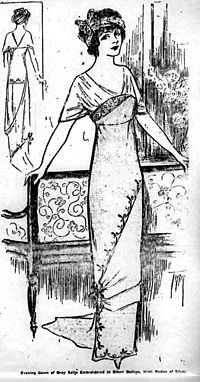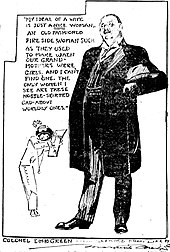

A hobble skirt was a skirt with a narrow enough hem to significantly impede the wearer's stride. It was called a "hobble skirt" because it seemed to hobble any woman as she walked. Hobble skirts were a short-lived fashion trend that peaked between 1908 and 1914.[1]



At a 1908 Wright Brothers demonstration in Le Mans, France, Mrs. Edith Ogilby Berg asked for a ride and became the first American woman to fly as a passenger in an airplane, soaring for two minutes and seven seconds.[2][3] She tied a rope securely around her skirt at her ankles to keep it from blowing in the wind during the flight. According to the Smithsonian Air and Space Museum, a French fashion designer was inspired by the way Mrs. Berg walked away from the aircraft with her skirt still tied and created the hobble skirt based on her ingenuity.[3]
The French fashion designer in the Berg story might have been Paul Poiret[2] who claimed credit for the hobble skirt, but it is not clear whether the skirt was his invention or not.[4] Skirts had been rapidly narrowing since the mid-1900s.[4] Slim skirts were economical because they used less fabric.[4]
The hobble skirt became popular just as women were becoming more physically active.[4]
Hobble skirts inspired hundreds of cartoons and comic postcards.[4] One series of comic cards called it the "speed-limit skirt."[2] There were several reports of women competing in hobble-skirt races as a joke.[4]
Boarding a streetcar in a hobble skirt was difficult. In 1912, the New York Street Railway ran hobble-skirt cars with no step up.[2] Los Angeles introduced similar streetcars in 1913.[5]
Hobble skirts were directly responsible for several deaths.[2] In 1910, a hobble-skirt-wearing woman was killed by a loose horse at a racetrack outside Paris.[2] A year later, eighteen-year-old Ida Goyette stumbled on an Erie Canal bridge while wearing a hobble skirt, fell over the railing, and drowned.[2]
To prevent women from splitting their skirts, some women wore a fetter or tied their legs together at the knee.[1][6] Some designers made alterations to the hobble skirt to allow for greater movement.[4] Jeanne Paquin concealed pleats in her hobble skirts while other designers such as Lucile offered slit or wrap skirts.[4]
The trend began to decline in popularity at the beginning of World War I, as the skirt's limited mobility did not suit the wartime atmosphere.[7]
The next time skirts would be narrow enough to impede movement would be with the sheath skirts of the 1950s, first introduced at the end of the 1940s.[8][9][10] Though shorter lengths (from just below the knee to the lower calf) and advances in fabric would enable a little more movement than in the hobble-skirt era,[11] the 1950s sheath skirt's new waist-to-hem tightness, said to reveal the shape of the leg, still created problems of mobility, with split seams a familiar occurrence.[12] Nonetheless, they were widely promoted by designers and the fashion industry, their narrowness exaggerated even more by having models pose with one leg directly in front of the other.[13] Some other skirt styles of the time also had very narrow hems, particularly the knee-length puffball/pouf skirts shown by Pierre Cardin and Yves Saint Laurent from 1958 to 1960. A few of Saint Laurent's 1959 skirts were so narrow at the hem that some fashion writers revived the word "hobble" to refer to them.[14][15] Sheath skirts remained part of the fashion picture into the early 1960s and then went very much out of style with the rise of the flared miniskirts of the mid- to late sixties[16][17][18] and the easy, comfortable clothes of the 1970s.[19][20][21][22]
Toward the end of the seventies, beginning in fall of 1978, some designers began reviving the narrow skirt silhouettes of decades past. Initially, many of them allowed some movement via slits,[23][24] though not always. Some were so inhibiting that the word hobble was once again used to describe them.[25] When the tight silhouette of the 1950s sheath skirt was revived in the early 1980s, it was somewhat less restricting, as it was now usually produced in stretchier, often knit fabrics and could even be in mini lengths, though there is only so much movement possible in a knee-length or longer skirt that is tight all the way to the hem.[26][27] These 1980s-style stretch sheath skirts in various lengths have been revived off and on ever since.
Movies and television
Music videos